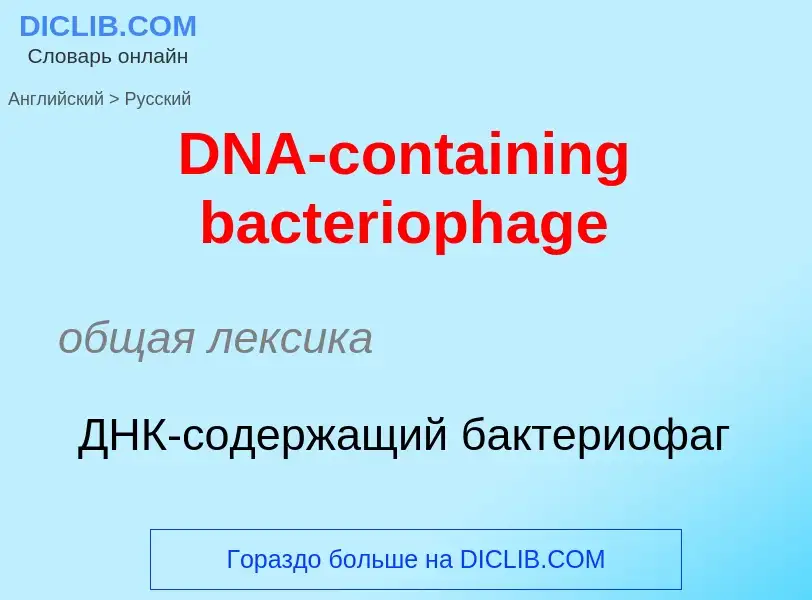Tradução e análise de palavras por inteligência artificial ChatGPT
Nesta página você pode obter uma análise detalhada de uma palavra ou frase, produzida usando a melhor tecnologia de inteligência artificial até o momento:
- como a palavra é usada
- frequência de uso
- é usado com mais frequência na fala oral ou escrita
- opções de tradução de palavras
- exemplos de uso (várias frases com tradução)
- etimologia
DNA-containing bacteriophage - tradução para russo
общая лексика
ДНК-содержащий бактериофаг
общая лексика
ДНК
дезоксирибонуклеиновая кислота
(Distributed Internet Application) распределённые приложения Интернет, архитектура DNA
(Digital Network Architecture) архитектура цифровой сети
сетевая архитектура, разработанная корпорацией Digital Equipment. Реализована в сети DECnet
синоним
Смотрите также
существительное
общая лексика
архитектура цифровых сетей
синоним
['s(j)u:pəkɔil]
общая лексика
суперспираль
спираль второго порядка
синоним
Wikipédia

Enterobacteria phage T2 is a virus that infects and kills E. coli. It is in the genus Tequatrovirus, and the family Myoviridae. Its genome consists of linear double-stranded DNA, with repeats at either end. The phage is covered by a protective protein coat.
The T2 phage can quickly turn an E. coli cell into a T2-producing factory that releases phages when the cell ruptures. Experiments conducted in 1952 by Alfred Hershey and Martha Chase demonstrated how the DNA of viruses is injected into the bacterial cells, while most of the viral proteins remain outside. The injected DNA molecules cause the bacterial cells to produce more viral DNA and proteins. These discoveries supported that DNA, rather than proteins, is the hereditary material.
The first phages that were studied in detail included seven that commonly infect E. coli. They were named Type 1 (T1), Type 2 (T2), etc., for easy reference; however, due to structural similarities between the T2, T4, and T6 bacteriophages, these are now commonly referred to as T-Even phages.
The phage can attach to the surface of a bacterium using the proteins on its 'feet' (tail fibers), and inject its genetic material (either DNA or RNA). This genetic material uses the host cell's ribosomes to replicate, and synthesize proteins for the capsid and tail of the phage. New phages are assembled within the cell until the cellular membrane lyses (splits open). The newly made phages are now free to attack more cells. This process is known as the Lytic cycle.




![DNA major and minor grooves. The latter is a binding site for the [[Hoechst stain]] dye 33258. DNA major and minor grooves. The latter is a binding site for the [[Hoechst stain]] dye 33258.](https://commons.wikimedia.org/wiki/Special:FilePath/DNA-ligand-by-Abalone.png?width=200)
![animated version]]). animated version]]).](https://commons.wikimedia.org/wiki/Special:FilePath/DNA animation.gif?width=200)

![B]] and [[Z-DNA]] B]] and [[Z-DNA]]](https://commons.wikimedia.org/wiki/Special:FilePath/Dnaconformations.png?width=200)

.jpg?width=200)




![[[Maclyn McCarty]] (left) shakes hands with [[Francis Crick]] and [[James Watson]], co-originators of the double-helix model based on the X-ray diffraction data and insights of Rosalind Franklin and Raymond Gosling. [[Maclyn McCarty]] (left) shakes hands with [[Francis Crick]] and [[James Watson]], co-originators of the double-helix model based on the X-ray diffraction data and insights of Rosalind Franklin and Raymond Gosling.](https://commons.wikimedia.org/wiki/Special:FilePath/Maclyn McCarty with Francis Crick and James D Watson - 10.1371 journal.pbio.0030341.g001-O.jpg?width=200)
![Interaction of DNA (in orange) with [[histone]]s (in blue). These proteins' basic amino acids bind to the acidic phosphate groups on DNA. Interaction of DNA (in orange) with [[histone]]s (in blue). These proteins' basic amino acids bind to the acidic phosphate groups on DNA.](https://commons.wikimedia.org/wiki/Special:FilePath/Nucleosome1.png?width=200)




![The Eagle]] [[pub]] commemorating Crick and Watson The Eagle]] [[pub]] commemorating Crick and Watson](https://commons.wikimedia.org/wiki/Special:FilePath/TheEaglePub-Cambridge-BluePlaque.jpg?width=200)





